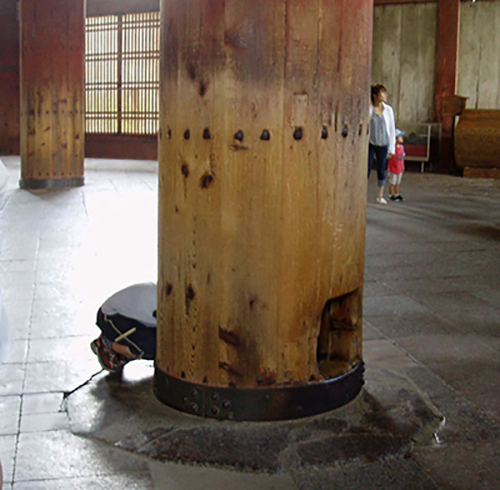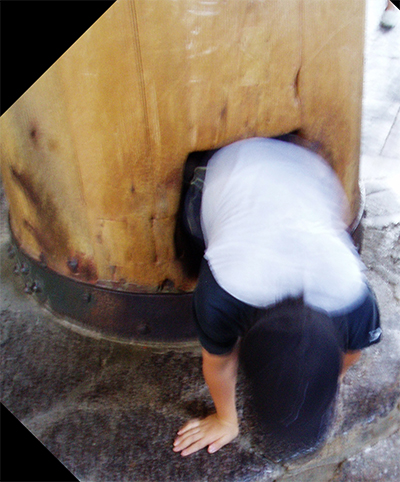

これ、やりますよね(笑)。
大仏殿の北東側の柱最下部に穴が空いていて、思わず通り抜けたくなる。
わたしはもうムリでしょうが、同行の息子は挑戦し無事クリア(笑)。
元々は「厄除け」のために穴があけられたのが理由のよう。
穴のある柱は大仏様の右後ろで方角で言うと「大仏殿の北東」柱。
この方角は「丑と寅の間、“艮(うしとら)”」で鬼門とされ
不吉で避けるべき方角とされます。
鬼門は邪気がたまり、気が乱れやすくなることから穴を開けることによって
邪気を逃がす役割を果たしているという。
無病息災・頭がよくなる御利益があるといわれるけれど・・・。
構造的には84本の集成柱で各1m超の太さなので1本程度が
その一部が中空になっても問題はないのでしょう。
ただ、こういう「穴開け」は東大寺側で仕掛けとして造作しない限り
参観者が自分で穴を開けたりはしないだろうと思います。
そうすると意図的に開口させているとわかる。
基本は国家的宗教建築の性格を帯びた施設であるので、
やはり鬼門の位置での厄除けというのが「方便」ではあったでしょうね。
しかしそこは俗世の「需要」というものにも配慮が必要。
国家的宗教施設として「動員力」も重要な要素になったに違いない。
そこで参詣する家族連れを顧客と見立てて「呼び物」を考えるのは
ごく自然な流れではないか。
で、前述のような方便を巡らして、事実上ディズニーランドのような
集客装置として擬して行ったのではないだろうか?
こういった大仏さん側の営業努力も甲斐あって
日本国民のシンボルの地位、声望を高めていったのではないでしょうか?
やはり地道な広宣活動が不可欠だと思われるなかで、
子どもたちや大人も、それこそ老若男女に奈良大仏がポピュラリティを
幅広く獲得していったに違いないと思います。
English version⬇
[Todaiji Temple Great Buddha Hall “Pillar Hole Going Through” Todaiji Temple Revisited -6]
I’ll do this (laughs).
There is a hole at the bottom of the pillar on the northeast side of the Great Buddha Hall, which makes you want to go through it.
I’m probably too tired, but my son who accompanied me challenged and cleared it safely (laughs).
Originally, it seems that the reason was that a hole was made for “apotropaic magic”.
The pillar with a hole is the pillar “northeast of the Great Buddha Hall” in the direction of the right back of the Great Buddha.
This direction is said to be a demon gate with “Ushitora” between Ox and Tora.
It is an ominous and avoidable direction.
By making a hole in the demon gate, it becomes easy to get confused because it accumulates evil spirits.
It is said that it plays a role in letting out evil spirits.
It is said that there is a benefit of being sick and smarter.
Structurally, there are 84 laminated pillars, each with a thickness of over 1 m, so about one is
There should be no problem if a part of it becomes hollow.
However, this kind of “drilling” is not done as a mechanism on the Todaiji side.
I don’t think visitors will make holes on their own.
Then you can see that it is intentionally opened.
Since it is basically a facility with the character of national religious architecture,
After all, it must have been a “convenience” to prevent evil at the position of the demon gate.
However, it is necessary to consider the “demand” of the world.
“Mobilization” must have become an important factor as a national religious facility.
Therefore, it is best to think of the family members who visit there as customers and think of “features”.
Isn’t it a very natural flow?
So, with the above-mentioned expedients, it’s virtually like Disneyland.
Isn’t it supposed to be a device for attracting customers?
The sales efforts of the Great Buddha are also worth it.
Isn’t it raising the status and voice of the symbol of the Japanese people?
While it seems that steady public relations activities are indispensable,
For children and adults, the Great Buddha of Nara makes it popular for men and women of all ages.
I think it must have been widely acquired.
Posted on 10月 3rd, 2021 by 三木 奎吾
Filed under: 住宅マーケティング, 日本社会・文化研究







コメントを投稿
「※誹謗中傷や、悪意のある書き込み、営利目的などのコメントを防ぐために、投稿された全てのコメントは一時的に保留されますのでご了承ください。」
You must be logged in to post a comment.